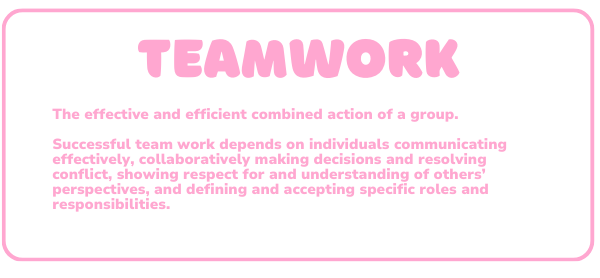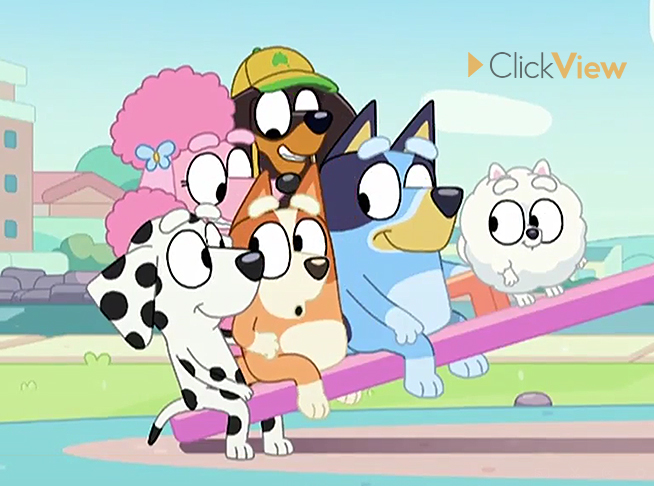Lesson summary
The animated series Bluey serves as a valuable tool in fostering children's development of imagination, curiosity, and social and emotional learning.
This lesson focuses on the capability of teamwork. Students will start by discussing how people can work together to achieve something impressive. Students then take part in an activity that explores tipping points and the role even the smallest contribution plays.
This suite of resources supports emotional and social learning and oral language development through a values framework. Each lesson uses intentional teaching strategies to develop a specific value. This lesson focuses on:

Click here for a full list of the values that underpin these lessons.
This lesson showcases a Bluey episode, which can be viewed on ClickView. Don't have a ClickView subscription? Bluey is also available on ABC iView. For real life!
Learning intentions
Students will:
- explore numeracy concepts in addition, ordinal numbers and more than / less than through a team activity
- reflect on times they have worked together to achieve something important.
Success criteria
Students can:
- identify the first and last object in a sequence
- count the quantity of objects in a group
- compare the number of objects in two groups
- consider properties such as weight and size of objects
- discuss whether an event is more or less likely to occur
- consider their contributions to a team or class activity.
Lesson guides and printables
Curriculum links
Select your curriculum from the options below.
Lesson details
Curriculum Mapping
Australian Curriculum (v9.0) content description:
Foundation Mathematics
- Quantify and compare collections to at least 20 using counting and explain or demonstrate reasoning (AC9MFN03)
- Identify and compare attributes of objects and events, including length, capacity, mass and duration, using direct comparisons and communicating reasoning (AC9MFM01)
Year 1 Mathematics
- Compare directly and indirectly and order objects and events using attributes of length, mass, capacity and duration, communicating reasoning (AC9M1M01)
Year 2 Mathematics
- Measure and compare objects based on length, capacity and mass using appropriate uniform informal units and smaller units for accuracy when necessary (AC9M2M01)
Year 3 Mathematics
- Identify practical activities and everyday events involving chance; describe possible outcomes and events as ‘likely’ or ‘unlikely’ and identify some events as ‘certain’ or ‘impossible’ explaining reasoning (AC9M3P01)
Syllabus outcomes: MAe‑1WM, MAe‑3WM, MA1‑3WM, MA1‑1WM, MA1-18SP, MA1‑1WM, MA1-18SP
General capabilities: Numeracy, Personal and Social Capability
Relevant parts of Foundation Year Mathematics achievement standards: Students can identify the attributes of mass and capacity and use direct comparison strategies to compare objects and events. They can represent practical situations that involve quantifying, equal sharing, adding to and taking away from collections to at least 10.
Relevant parts of Year 1 Mathematics achievement standards: Students can compare and order objects and events based on the attributes of length, mass, capacity and duration, communicating reasoning.
Relevant parts of Year 2 Mathematics achievement standards: Students can use uniform informal units to measure and compare shapes and objects.
Relevant parts of Year 3 Mathematics achievement standards: Students can use practical activities, observation or experiment to identify and describe outcomes and the likelihood of everyday events explaining reasoning.
Resources Required
- Bucket with handle
- Wooden skewers or wooden popsticks
- Two tables
- Small classroom objects of different shapes and sizes
- Blocks, erasers, counting tokens, etc. Anything small enough to fit a number in the bucket
- (Optional) Set of scales
- (Optional) Tug of war rope or long skipping rope.
Additional Info
This is not an official Bluey lesson. Cool.org does not have an official partnership with Bluey.


Welcome back!
Don't have an account yet?
Log in with:
Create your free Cool.org account.
Many of our resources are free, with an option to upgrade to Cool+ for premium content.
Already have an account?
Sign up with:
By signing up you accept Cool.org's Terms and Conditions(Opens in new tab) and Privacy Policy(Opens in new tab).